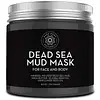What's inside
What's inside
 Key Ingredients
Key Ingredients

 Benefits
Benefits

 Concerns
Concerns

 Ingredients Side-by-side
Ingredients Side-by-side

Water
Skin ConditioningSea Silt
Skin ConditioningKaolin
AbrasiveGlycerin
HumectantMoroccan Lava Clay
AbrasiveTrehalose
HumectantNiacinamide
SmoothingPaeonia Suffruticosa Root Extract
Skin ProtectingPanthenol
Skin ConditioningBetaine
HumectantBeta-Glucan
Skin ConditioningDipotassium Glycyrrhizate
HumectantXylitol
HumectantSodium Hyaluronate
HumectantCaprylhydroxamic Acid
Parfum
Masking1,2-Hexanediol
Skin ConditioningAllantoin
Skin ConditioningSolanum Tuberosum Starch
AbsorbentWater
Skin ConditioningZea Mays Starch
AbsorbentKaolin
AbrasiveSimmondsia Chinensis Seed Oil
EmollientMineral Salts
Skin ConditioningGlycerin
HumectantPalm Alcohol
Skin ConditioningHelianthus Annuus Seed Oil
EmollientButyrospermum Parkii Butter Extract
Skin ConditioningBetula Alba Bark Extract
MaskingAloe Barbadensis Leaf Extract
EmollientCalendula Officinalis Flower Oil
MaskingDimethicone
EmollientTrehalose
HumectantCaprylic/Capric Triglyceride
MaskingBeeswax
Emulsion StabilisingTocopheryl Acetate
AntioxidantXanthan Gum
EmulsifyingAllantoin
Skin ConditioningSodium Hyaluronate
HumectantLavandula Angustifolia Oil
MaskingSolanum Tuberosum Starch, Water, Zea Mays Starch, Kaolin, Simmondsia Chinensis Seed Oil, Mineral Salts, Glycerin, Palm Alcohol, Helianthus Annuus Seed Oil, Butyrospermum Parkii Butter Extract, Betula Alba Bark Extract, Aloe Barbadensis Leaf Extract, Calendula Officinalis Flower Oil, Dimethicone, Trehalose, Caprylic/Capric Triglyceride, Beeswax, Tocopheryl Acetate, Xanthan Gum, Allantoin, Sodium Hyaluronate, Lavandula Angustifolia Oil
Ingredients Explained
These ingredients are found in both products.
Ingredients higher up in an ingredient list are typically present in a larger amount.
Allantoin is a soothing ingredient known for its protective and moisturizingg properties. Because of this, it is often added to products with strong active ingredients.
Studies show higher concentrations of this ingredient can promote wound healing.
Though it can be derived from the comfrey plant, allantoin is produced synthetically for cosmetic products to ensure purity.
Learn more about AllantoinGlycerin is already naturally found in your skin. It helps moisturize and protect your skin.
A study from 2016 found glycerin to be more effective as a humectant than AHAs and hyaluronic acid.
As a humectant, it helps the skin stay hydrated by pulling moisture to your skin. The low molecular weight of glycerin allows it to pull moisture into the deeper layers of your skin.
Hydrated skin improves your skin barrier; Your skin barrier helps protect against irritants and bacteria.
Glycerin has also been found to have antimicrobial and antiviral properties. Due to these properties, glycerin is often used in wound and burn treatments.
In cosmetics, glycerin is usually derived from plants such as soybean or palm. However, it can also be sourced from animals, such as tallow or animal fat.
This ingredient is organic, colorless, odorless, and non-toxic.
Glycerin is the name for this ingredient in American English. British English uses Glycerol/Glycerine.
Learn more about GlycerinKaolin is a clay. It is used for oil control and to help minimize pores. Like other clays, kaolin has the ability to absorb excess sebum or oil. This can help clean out pores and mattify the skin.
Some types of kaolin may have exfoliating properties. When water is added to kaolin, it becomes a paste with small abrasive particles.
Most kaolin is a white color, but may be pink/orange/red depending on where it comes from.
The name 'kaolin' comes from a Chinese village named 'Gaoling'. Kaolin clay comes from rocks rich in kaolinite. Kaolinite, the mineral, has a silicate layered structure. Kaolinite is formed from chemical weathering of aluminum siilicate minerals.
Besides skincare, kaolin is commonly used to make glossy paper, in ceramics, toothpaste, and as medicine to soothe stomach issues.
Learn more about KaolinSodium Hyaluronate is hyaluronic acid's salt form. It is commonly derived from the sodium salt of hyaluronic acid.
Like hyaluronic acid, it is great at holding water and acts as a humectant. This makes it a great skin hydrating ingredient.
Sodium Hyaluronate is naturally occurring in our bodies and is mostly found in eye fluid and joints.
These are some other common types of Hyaluronic Acid:
Learn more about Sodium HyaluronateTrehalose is a disaccharide made of two glucose molecules (glucose is sugar!). Trehalose is used to help moisturize skin. It also has antioxidant properties.
As a humectant, trehalose helps draw moisture from the air to your skin. This helps keep your skin hydrated.
Due to its antioxidant properties, trehalose may help with signs of aging. Antioxidants help fight free-radical molecules, unstable molecules that may damage your skin.
In medicine, trehalose and hyaluronic acid are used to help treat dry eyes.
Some animals, plants, and bacteria create trehalose as a source of energy to survive freeze or lack of water.
Learn more about TrehaloseWater. It's the most common cosmetic ingredient of all. You'll usually see it at the top of ingredient lists, meaning that it makes up the largest part of the product.
So why is it so popular? Water most often acts as a solvent - this means that it helps dissolve other ingredients into the formulation.
You'll also recognize water as that liquid we all need to stay alive. If you see this, drink a glass of water. Stay hydrated!
Learn more about Water